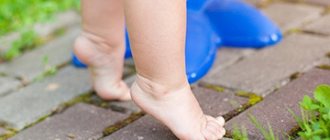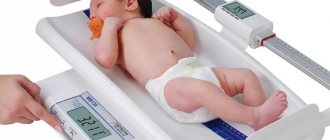21.01.2020 11284 0
- Historical reference
- Advantages
- Flaws
- Danger to the spine
- Danger of injury
- How to choose a walker?
- Contraindications to using walkers
- Separately about the boys
- Separately about girls
Some parents consider the purchase of baby walkers something important and put such a purchase on a par with a crib, stroller and bathtub. They are often given as gifts by relatives of young parents. But the question of whether a child needs a walker remains open. Let's figure out whether it's worth buying them at all and at what age can they be used?
Historical reference
Walkers originally appeared back in the 1940s and were invented as an assistive device for the disabled and elderly. The purpose of this device was to maintain an upright position and balance when walking. Walkers for children appeared a little later - in 1953. But they acquired their modern appearance only in the seventies. In Russia, walkers appeared on store shelves twenty years ago. Soviet doctors considered walkers harmful to the development of children, so the country banned their production and sale. Some modern experts completely agree with their senior colleagues, declaring that the device is harmful. Nevertheless, many parents continue to use this device for their kids. So, if you are thinking about purchasing a walker, you need to carefully weigh the pros and cons.
Are walkers harmful to children: myth or reality?
photo from the site https://vetinpharm.com
At first glance, using a walker looks very attractive. But if you consider the long-term prospects and current dangers that walkers for children entail, the benefits or harms will outweigh, it’s not difficult to say. Official medicine, represented by orthopedists, clearly says that this device is harmful, and therefore their production and sale is prohibited in a number of countries. The harm of walkers for a child consists of the following points:
- The start of walking is delayed. The baby completely satisfies the need for vertical movement, and the motivation to take independent steps weakens.
- Load on the spine. Nature intended that the baby begins to walk only when the muscular frame around the spine is strong enough and able to withstand vertical load. By placing a child who is not yet walking in a walker, you are giving him a load that he is not yet ready for.
- Inability to fall. Bent legs and falling from a still insignificant height of one’s own height is a mandatory stage in developing the skills of falling correctly. The baby learns to group, raise his head and fall on his buttocks or side, reducing the likelihood of injury. Children in walkers are deprived of this opportunity, because instead of falling, they simply hang on the seat.
photo from the site https://vsedeti-ok.ru
- The development of coordination is delayed. When walking in a walker, the cerebellum does not receive signals about the need to maintain balance, and the development of its functions is delayed. As a result, during the first attempts to walk independently, the child falls forward or to one side.
- Incorrect foot placement. To move, the baby makes pushing movements with his toes, without placing his foot on the full foot and without making movements with it in the vertical plane.
- Load on the musculoskeletal system of the legs. If the height of the walker is incorrectly adjusted, when used for a long time, it can cause deformation with bending of the legs.
- Lack of caution. The mother is absolutely calm about the baby, because bumpers protect him on all sides, but at the same time the child does not receive the necessary negative experience from collisions with foreign objects and does not learn to be careful.
- Limiting sensory experience. Having reached the desired item, the baby is deprived of the opportunity to touch it or taste it. This is a very important point in the formation of interhemispheric connections, and by limiting it, parents do not allow logic to develop.
Considering the above facts about whether walkers are harmful for children, Komarovsky definitely does not recommend using them before reaching 9 months of age. Only after this the degree of development of the organism neutralizes the potential negative impact of staying in them.
photo from the site https://www.hb-happybaby.com
When considering even modern baby walkers, it is impossible to evaluate the pros and cons without taking into account the significant risk of injury of the device. The absolute safety of a child sitting in a walker is nothing more than an illusion, and the mother must clearly understand what dangers await the baby at this time:
- Possibility of injury to fingers on the upper bumper. Although the lower bumper is made larger than the upper one to prevent this risk, this only works in the case of continuous vertical surfaces. Furniture with legs allows the lower bumper to pass under itself, and the child crashes into a hard surface with his fingers lying on the upper bumper.
- The speed of movement on wheels is quite significant, and in a fairly spacious room the child accelerates to 10 km/h. With such acceleration, any obstacle that gets under the wheels can cause the walker to tip over.
- Even at low speed, the wheels can get caught on the threshold of a room, the edge of a carpet, or things in the way, which also threatens a rollover accident.
- If the door to the room opens in the direction where the child is, he may well block it by driving up close and not understanding how to drive away. This is especially true for narrow corridors, so there are often cases when mom finds herself locked in the bathroom or toilet.
If, after considering all the pros and cons of walkers for children, you still decide to use them, the direct responsibility of the parents is to completely protect the baby.
Advantages
Well-known pediatrician Evgeny Komarovsky considers walkers to be a device needed by parents, not their child. It is enough just to put the child in the walker and do household or work chores. The baby from them will not go anywhere, will not fall, will not run into a sharp corner and, of course, will not cause unnecessary trouble*. At the same time, modern walkers are a thing that can really attract a child’s attention. They are made bright, often complemented with a play area, even musical devices. A child in a walker is much more interesting than in a crib or playpen. And some supporters of this device claim that walkers are beneficial because they have a developmental function.
Pros and cons of baby walkers
Advantages of walkers for children:
- The child likes to be in them, they can explore the apartment and visit places where it is usually impossible to go
- The baby can be close to his mother, without interfering with her doing her business and without being in danger
- The toddler's horizons are expanding, he is actively exploring the world. Previously, he could only see the apartment from the playpen or crib, but now - from almost any corner. He can look and explore new things, and even touch them. The main thing is to make sure that there are no dangerous objects nearby within the reach of the baby in the walker. Remember: a child is interested in almost everything, and he often learns new things “by taste.”
- The child is safe, even if he goes to another room on his walker. There is no need to keep it in sight all the time. Parents have their hands free, because now their baby can be left to his own devices for a full half hour a day
- The baby learns new things: turn around, look around. This further strengthens the muscles and trains the baby’s brain.
Disadvantages of walkers:
- Incorrectly fitted product may cause injury
- To travel safely and see a lot of interesting things, you need a lot of space. Therefore, walkers are more suitable for relatively large apartments. In small rooms, the child will have nowhere to turn around and nothing to look at.
- No matter how safe, expensive and high-quality walkers are, you must not let your guard down. And there is some element of danger. You cannot leave a child alone in a walker for half an hour; he still needs to be looked after periodically. First of all, it is necessary to remove all potentially dangerous objects from the baby’s reach. Please note that the thresholds between rooms are not too high, otherwise the baby may roll over and get injured.
- Do not leave your child in a walker for a long time
Walkers will be as safe as possible for the baby if they are purchased after consultation with a doctor, preferably a specialist pediatrician. Choose models that are optimal for the price, do not be tempted by the cheapness. And check the quality of the paint on the surface of the walker, because the baby will most likely lick the table. Baby walkers are not a way to free up more free time, but an opportunity to diversify and make your baby’s world more interesting and educational.
Danger to the spine
A newborn baby can only lie down, then he learns to roll over, then sit down, and only after that he learns to stand and walk. This sequence is important for the proper development of the musculoskeletal system. The child will begin to sit only when his spine is sufficiently strong, and will walk when the muscles of his legs become stronger. Evgeniy Komarovsky believes that a child should go through all these stages independently, and only when the child’s body is ready for this*. Forcing a child to take a vertical position before his spine becomes stronger is a sure path to spinal diseases. But this is only dangerous if parents decide to use a walker for a child who does not yet know how to move independently or at least sit. From what months can a child move independently? Doctors say that walkers are contraindicated for babies under 9 months.
What does Dr. Komarovsky think?
Evgeny Komarovsky
Children's doctor, TV presenter, author of books about children's health and common sense.
Humanity has been using walkers for several decades. Many studies have been conducted, there are very specific statistics, and conclusions have been drawn. About the conclusions later, but now the information:
- “Walkers teach children to walk” is an illusion and misconception. The movements performed by the child are only similar to walking, but completely different muscles work and motor coordination skills are not formed. As a consequence, when using a walker, the desire to walk normally and the ability to walk normally arise later;
- Using a walker greatly increases the risk of serious injury. The most dangerous thing is falling from thresholds, stairs, into a pool, etc., as well as the situation when the walker lands on a surface with an inclination. An important additional factor that increases the severity of injuries is the relatively high speed of movement;
- Pediatric associations in some countries explicitly urge parents not to use walkers.⠀
ADVIСE:
- No need to buy a walker! Learning to walk while holding onto furniture or an adult’s hand is both more effective and safer.
- If there are walkers in the house, and you cannot deny yourself the pleasure of using them, ensure that access to stairs, thresholds, and water is impossible.
- Under no circumstances should you purchase a walker that does not have wheel locking features. The wider the walker, the safer it is - there is less risk of tipping over and less chance of squeezing through doors.
- Consider that you have the opportunity to replace your walker with other devices that are both useful and safe.
Danger of injury
Researchers at Nationwide Children's Hospital report another danger from the device: From 1990 to 2010, more than 250,000 children were admitted to emergency rooms due to walker-related injuries. So buying a walker to leave your child alone in the room is not a good idea. What conclusions can be drawn?
- Walkers do not relieve parents of responsibility for the life and health of the baby: they need to be monitored
- This device is not intended for use by children under 9 months of age.
- Staying in a walker should be limited to an hour a day.
Can children have walkers?
If you follow all the rules, yes, the risk of using walkers can be easily minimized.
Why is it profitable to buy baby walkers on avtokrisla.com?
The online store offers a wide range of products that are suitable for young customers and their parents. In the catalog you will find high-quality toys for girls and boys, as well as other products. All popular types of baby walkers are presented here: from classic to gurneys. They are equipped with interesting additional functions so that the baby does not get bored exploring the world around him.
If you are planning to purchase a baby walker, you need to pay attention to some points:
- a rectangular frame is considered more stable - but stick to models whose base width is larger than the diameter of the tabletop;
- In order for walkers to be as reliable as possible, you should pay attention to options with 6-8 wheels (this number is considered optimal), but for quieter movement it is recommended to purchase ones that have silicone attachments on the wheels;
- the seat should have a hard back, covered with a fabric that is pleasant to the touch;
- the tabletop is often equipped with additional educational toys, you can also add your own items, but make sure that there are no gaps where the baby can stick his finger;
- It is important that the model has a height adjuster - this way you can easily adjust the design to your baby’s parameters, reducing the load on the spine.
When purchasing products from the online store avtokrisla.com, you can be sure that you are getting reliable and durable products. The company has been operating on the Ukrainian market since 2005 and offers only proven toys, accessories and useful things for children and parents.
How to choose?
Choosing a walker is very difficult. The range of this product is quite large: there are both budget options and models from the “luxury” segment. Moreover, they can differ not only in materials, but also in the presence of additional modules, special safety brakes that prevent falls from stairs, and a host of other characteristics. Before choosing the right walker, you should read reviews from real owners. What should you pay attention to?
A solid foundation.
It should be wide enough and made of metal or thick plastic. The fastening and quality of the wheels is important. They are usually made of durable plastic, which is used for office chairs. Wheels on walkers can be made of silicone. They are silent and do not scratch floor coverings.
Separately, you should pay attention to the fastenings
: they should not fly out, but at the same time they should rotate easily. It’s nice if they have a lock that allows you to “immobilize” the walker.
Seat and back
. The seat should be soft, with adjustable seating depth. Preferably the seat is made of hydrophobic material and is removable for washing.
The backrest is soft, but with a dense base to support the child's back in an anatomically correct position. The height of the seat and backrest should be adjusted as the child grows.
Additional modules.
This can be a table (then the walker can also be used as a high chair), music buttons, toys and other bright additions.
Types of walkers
Walkers are like this:
- Classic, which have the simplest design without unnecessary elements and additional gadgets.
- Transformers. Such walkers can be a high chair, a rocking chair, or a swing. They are adjustable in height and width.
- Pushers. The design resembles a rolling toy that is placed in front of you. To start moving, the child needs to start pushing the device.
Contraindications for use
You should not put your child in a walker if:
- The baby has increased or decreased tone of the legs
- The device is not suitable for the child’s height: he is forced to either walk on his toes or, on the contrary, bend his knees
- The child has diaper rash or skin damage where the walker comes into contact
- The baby has signs of rickets or impaired function of the musculoskeletal system.
There are special walkers for children with cerebral palsy, which should be purchased only after consultation with a specialist. And for other children, doctors recommend adhering to the following recommendations:
- Be sure to put your baby's shoes on before putting him in the walker.
- Make sure your child is positioned in the seat
- Limit your baby's time to 40–60 minutes
At what age can a child be placed in a walker?
There is no exact and definite answer. Doctors recommend a period of 6 to 8 months. At this age, most children are prepared to stand upright with support physically and psychologically. Most, but not all. Solve the issue individually.
To determine exactly what time you can put your child in a walker, take a close look at your favorite little one. Assess his physical condition. If your child is good at or can do the following, feel free to buy a walker and put your little fidget in it:
- Crawls well on all fours.
- Sits without support, does not fall back or sideways.
- Stands in the crib, near the support.
- Can or tries to stand up on his own.
- The baby does not have any pathologies of the musculoskeletal system or rickets.
- The baby is curious and wants to actively explore the world.
- The baby is 6 months or older.
On a note! Dr. Komarovsky clearly believes that the realization of the desire to use a walker should be delayed closer to 8–9 months. The TV doctor's opinion can be found here.
Separately about girls
While parents worry about boys, walkers are more harmful to girls, as they are more at risk of developing hip dysplasia. This disease of the musculoskeletal system is aggravated by being in a walker, especially if it is not diagnosed in time. So walkers for girls may be more dangerous than walkers for boys. Before buying this device, you should consult with a specialist.
(2 ratings; article rating 3.5)
Share Share Share
Benefits of using baby walkers
Walkers were invented to solve several problems. So some of the benefits you'll get are based on the problems they solve.
These include:
- They keep your child busy. Most baby walkers come with built-in toys that keep your baby engaged.
- They stimulate your child's cognitive process. This is because built-in toys come in different colors and shapes. Your baby will spend a lot of time trying to figure out what the different elements are.
- This encourages the child to try to walk. It is easier to get your child moving in a walker since it is supported by the walker.
- Children get the opportunity to experience a form of independence. You don't have to hover behind them as they take every step trying to stop their fall.
Walkers help with several aspects of your baby's growth. It is a useful and exciting tool for child development.











